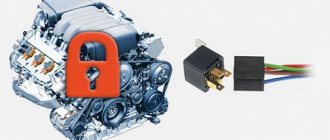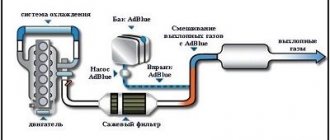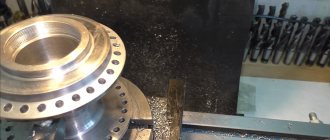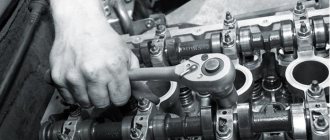Automotive giants like Mercedes, Toyota, BMW and many others are in constant competition with each other for a place in the global market, and in order to supply truly unique cars, the most talented engineers and designers of the companies work on hundreds of innovative projects every year. Some of these projects managed to gain success and become “standard” systems, units or components installed on the majority of cars of a particular series. An example of such a device is the VANOS system on BMW.
What is Vanos in an engine?
Cutaway view of the engine showing the “double” vanos
Variable Nockenwellen Steuerung is translated from German as variable control of the engine camshafts. BMW engineers came up with this system. VANOS is essentially a variable valve timing system. Its peculiarity is that it is capable of changing the position of the camshafts in relation to the crankshaft. Thus, the phases of the gas distribution mechanism (GRM) are regulated. This regulation can occur in the range from 6 degrees advance to 6 degrees retard relative to top dead center.
Rubber wear
As you know, no one has yet managed to create an ideal metal piston. They always have microscopic gaps, which, however, are sufficient for gas leakage. In addition, deformations occur in the pistons during operation. They also do not benefit the tightness. To create it, special piston sealing rings made of flexible and durable materials are used.
The BMW company focused its attention on tires (also called Buna). Over time, this rubber, although very reliable, like everything German, begins to harden under the influence of powder gases and temperature changes
After this she can:
Because of this, tightness is lost and the piston requirement for oil pressure increases. And after a while Vanos stops working altogether.
The problem is solved by replacing the rings with new ones. However, BMW itself does not sell rings, it only repairs entire blocks. You will have to purchase components from other manufacturers.
How it works and what it consists of
VANOS is located between the camshaft and the drive gear. Its design is relatively simple. The main part of the system is the pistons, which change the position of the camshafts, thereby changing the valve timing. These pistons interact with the camshaft gears using a toothed shaft that connects to the piston. The movement of these pistons is ensured by oil pressure.
The principle of operation of oil pistons that regulate the operation of the gas distribution system
The design includes a special solenoid valve, the operation of which is controlled by the electronic engine control unit (ECU). Information from camshaft position sensors is taken as input data. Thanks to this sensor, the current angular position of the shafts is determined. The received data is then sent to the ECU to compare the received value with the specified angle.
Thanks to these changes in the position of the camshafts, the valve timing changes. As a result, the valves either open a little earlier than expected, or a little later than in the original position of the shafts.
Advice for BMW owners
If there is a distinct, constant knocking noise under the hood, a noticeable decrease in engine power and problems with idling, you will have to remove and disassemble the vanos valve. Any motorist can do this using a standard set of tools.
You can check the degree of wear by simply pressing in the control piston. If it sinks in smoothly and is pushed back by the spring, it will be enough to replace the O-rings.
Otherwise, it is necessary to sand the element itself and the cylinder or completely replace the moving element. Solving problems with the Vanos solenoid valve should begin by checking the integrity of the wiring. Its restoration is often a sufficient solution.
How the system works
BMW currently uses fourth-generation variable camshaft control (VANOS) technology in its engines. It is worth noting that the first generation of this technology was called Single VANOS. In it, only the intake camshaft was subject to regulation, and the exhaust phases were changed discretely, i.e. in leaps and bounds.
First generation or “single” Vanos
The essence of the work of such a system was this. The position of the intake camshaft was adjusted in accordance with engine speed and data from the accelerator pedal position sensor. If a small load was applied to the engine (low speed), then the intake valves began to open later, which, in turn, makes the engine idle smoother.
Early opening of the intake valves at medium engine speeds allows increasing the amount of torque, as well as improving the circulation of exhaust gases in the combustion chamber, which, in turn, reduces overall fuel consumption and exhaust toxicity. High engine speeds cause the intake valves to open later, resulting in maximum power. In the first few minutes after the engine starts, the system activates a special mode, the essence of which is to reduce the warm-up time as much as possible.
Second generation VANOS (also called “vanos vanos” or “double vanos”)
Nowadays the so-called Double Vanos is used. Unlike the “single-vane system”, the operation of the intake and exhaust camshafts is regulated in a double one, and their control occurs more smoothly, without jerking. Thanks to the use of the updated system, it was possible to significantly increase the torque and power of the engine throughout its entire speed range. Also, according to the BiVanos operating scheme, a small part of the exhaust gases can be re-burned in the combustion chamber, which, in turn, leads to an increase in the environmental friendliness of the engine.
Now all cars of the German brand use the fourth generation Vanos system. The key feature of this version is that it uses Vanos intake/exhaust camshaft gears. BMW engineers have made the system more compact - now the entire actuator is located in the timing sprockets themselves. Well, in general, the fourth generation of the system is similar in principle to Single Vanos.
About service
The oil will have to be changed more often. Ideally, once every 6,000 km, since the engine will operate at a different power that was not included by the engineers at the design stage. Stop listening to those who yell that the oil can be changed once every 13,000 km. and don't bother.
You need to place higher demands on the oil itself, pour only normal oil, without saving, and simply avoiding counterfeits.
Change the o-rings on the pistons more often, yes, it will be time-consuming, but it will save a lot of money in the future. Replacement will eliminate the problems of their play and increased wear.
These 2 simple manipulations will help protect Vanos itself, and the engine from loss of life. For example, VANOS itself costs around $1000 (if we take a new, original one). If you have the option of purchasing it from disassembly at a quarter of the price, do not count on its perfect condition, all the cracks will be revealed very quickly.
Buy only original repair parts. kits, do not be fooled by Chinese or other analogues. We can recommend you a good online service https://dlt-audit.ru/ Playing online on the platform is also beneficial because you can earn decent money here. Average price of repair set - $60
With proper maintenance, the system can easily cover 500,000 km. And unreasonable savings will reduce this figure to 300,000 km. If everything is installed correctly, using living elements, then the system, even in the emergency stage of a breakdown, will work to the maximum of its resource, this is a feature of the entire BMW concern, at least of the old school.
Typical faults and their symptoms
- Destruction of sealing rings. We are talking about oil piston rings that regulate the position of the camshafts. Due to numerous factors - high/low temperature, various harmful substances that get on the rubber, the latter begins to lose its elastic properties over time and crack. It is because of this that the tightness inside the mechanism disappears.
- Wear of washers and bearings. The oil pistons are designed with metal bearings and washers. Over time, they also begin to deform, since initially they have a small margin of safety. You can find out that you need to change the bearing/washer in the VANOS system by listening to the engine - you can hear an unpleasant, sharp metallic noise.
- Chips and dirt on flanges and pistons. We are talking about deformation of metal parts. This could be due to a rather aggressive driving style, low quality oil/gasoline, or simply high mileage. Chips and scuffs form on the front edge of oil pistons or gas distribution shafts. As a result, there is a loss of power/torque and unstable engine operation in idle mode.
If the car’s engine begins to vibrate strongly at idle, rather poor acceleration is noticed throughout the entire speed range, increased fuel consumption appears, and metallic sounds occur when the engine is running, then most likely the VANOS system requires urgent attention. A clear sign of poor performance are problems with starting the engine, spark plugs and detonation.
Is it worth installing it?
If you bought a used BMW and want to go sideways like all the boys in the area, we hasten to upset you - this is not your option. Firstly, with an old engine, you won’t be able to fully reveal Vanos’ potential, and secondly, you’ll kill the engine, which is most likely outliving its time anyway.
As a result, you will simply waste money and time, and if you sell, you will not get back even part of the money invested.
It only makes sense to install it when you are confident in the service life of the engine. For example, they personally did a major overhaul on it (or are sure that the previous owner did it), or an option when replacing the engine with a contract one.
Where to start checking
Unfortunately, the BMW automaker prefers to repair all Vanos models itself, accepting them for repairs, but not producing spare parts or professional diagnostic equipment for them. However, over the past decades, car owners themselves have accumulated some knowledge on how to check and repair these units. To begin with, you should use your own senses:
- Hearing - any extraneous sounds, rustling, knocking, clanging, indicate that some parts require replacement;
- Touch - with the engine running, you need to put your hand on the Vanos and check if you feel any extraneous vibration, which may indicate a defect in the operation of the bearing or pistons in the cylinders.
Vanos system for BMW cars with N52 and N52N series engines
Many owners of BMW cars with an N52 engine have encountered problems with the gas distribution system. And when they talk about BMWs, they are often associated with the Vanos system. Let's delve a little deeper into this issue and see how it all works.
1-oil channel from the oil filter
2-solenoid valve for Vanos exhaust system
3-solenoid valve Vanos intake system
4-main timing chain tensioner
Vanos 5-way exhaust side check valve
6-way Vanos intake side check valve
Repairing VANOS today is impractical; in most cases it is replaced.
BMW World Technical Center has significant experience in repairing the VANOS system on BMW with engines of the series: M52, M54, M62, N46. Please note that on engines N52, N53, N54, N62 and N63 only VANOS replacement is carried out; in other cases, repairs are possible, but this issue must be resolved with a specialist who, after diagnosing the internal combustion engine, will offer you the optimal solution to fix the problem with Vanos in your BMW.
We recommend the following sequence of actions in case of problems/malfunctions with the VANOS system:
- Flushing the engine lubrication system with a special cleaner to dissolve deposits in the oil channels.
- Changing engine oil with oil filter.
- Washing VANOS solenoids on an ultrasonic stand.
- Flushing or replacing VANOS check valves.
- Resetting adaptations and corrections of the engine control unit.
- Repeated diagnostics after 100 km.
This method will allow you to fix VANOS problems less expensively. If the error remains and there is no engine traction, then repair of the Vanos system is necessary, which includes: replacement of the VANOS actuator units, timing chain, tensioner and tensioner bars.
Repair kits for BMW
BMW cars are the standard of safety, reliability and comfort, but they do not last forever: over time, individual components begin to “fail”, more fuel is spent than before, and with difficulty, especially if the thermometer drops below zero. In this situation, you have three options:
Give the car for repair. Buy a repair kit for BMW from an official dealer. Pay attention to repair kits for BMW from Bersa Tools.
Let's consider each option separately.
Repair
We, of course, know that there are honest auto mechanics who do exactly what is required and don’t charge a penny more than necessary, but such super-people are rare in real life. It's much more likely that you'll be billed not only for repairing the broken part, but also for half a dozen jobs you didn't order. To answer all your questions, the master will explain that “everything was on its last legs” there, and it’s simply a miracle that you turned up in such a timely manner.
Official dealer
“Native spare parts” are good for everyone: both in quality and appearance. The only bad thing is that they cost like an independent car: not a BMW, of course, but something from the domestic automobile industry - quite good. In addition, parts from the official manufacturer are sold in already complete sets, and even if you only need one membrane, you will still have to buy everything else to go with it. Unnecessary elements will safely find their place somewhere on the mezzanine or in the corner of the garage, and so they will disappear there - just like your overpaid money.
Repair kits for BMW from Bersa Tools
We manufacture all our products ourselves, and therefore guarantee their European quality at domestic prices. The repair kit includes not only the damaged spare part, but also the tools necessary to repair it, as well as consumables and components. The catalog of repair kits for BMW includes lock cylinders, air suspension compressors, Hall sensors, KVKG membranes, handbrake electric motors and many other kits. If you haven’t found the part you need, don’t despair, our range is constantly expanding and sooner or later we will definitely be able to offer you what you need. And if you call, it is possible that our consultant will already find an alternative option for you: some repair kits are suitable for several models at once.











